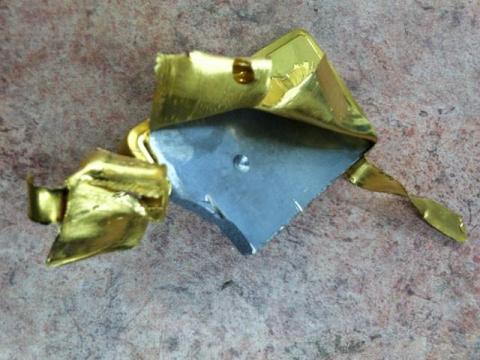Counterfeit Gold Bars found in Manhattan
More Fake Gold Bars Found in Manhattan

After Manhattan bullion dealer Ibrahim Fadl reported that he discovered tungsten filled gold bars, the story caused quite a stir amongst the global bullion industry. The New York Post followed up on the story, revealing that a number of counterfeit 10oz PAMP gold bars had been sold to different dealers.
Fadl said he did his due diligence “by X-raying the bars to ascertain the purity of the gold and weighing the bars, and the Swiss markings were perfect.”
X-ray flouresence will only test to 20 microns below the surface, which is about 1/5 the width of a human hair. With advanced refined laser imaging and die stamping technology, counterfeiters are able to replicate any metal markings. Tungsten is chosen as the substitute metal for the core of counterfeit gold bars as it is cheap and has nearly the exact same density as gold.
Had Fadl included ultrasonic testing as part of his due diligence, he would have avoided buying counterfeit bars. Detection by ultrasound is the most affordable, convenient and discrete way to protect your wealth and avoid tungsten inserts in gold bars and other base metal alloys in silver bars.
NEW YORK POST
Diamond District finds 10 tungsten-filled bars
By MICHAEL GRAY
Last Updated: 11:49 PM, September 23, 2012
Posted: 10:37 PM, September 22, 2012
Federal agents are investigating the peddling of bogus gold bars in Midtown.
The Post has learned as many as 10 fake gold bars — made up mostly of relatively worthless tungsten — were sold recently to unsuspecting dealers in Manhattan’s Midtown Diamond District.
The price of gold has risen more than 600 percent since January 2000, while the S&P 500 index is down 0.6 percent over the same period.
The 10-oz. gold bars are hugely popular with Main Street investors, and it is not known how many of the fake gold bars were sold to dealers — or if any fake bars were purchased by the public.
Gold refiner Ibrahim Fadl claims he was sold four bogus bars, which were covered with a thin layer of gold, and filled with a tungsten slug.
One gold dealer discovered that four of the 3-inch-by-1-inch gold bars he bought — worth about $72,000 retail — were counterfeit.
“It has the entire street on edge,” said Ibrahim Fadl, 62, who has been the owner of Express Metal Refining, a Midtown gold-refinery business, for the last 11 years. “I and the others on the street work off of trust; now that trust is strained.”
Fadl, a Columbia University graduate with a master’s degree in chemical engineering, and who has more than 40 years in the industry, purchased the four fake bars from a well-known Russian salesman with whom he has done business.
A second 47th Street refiner, who wished to remain anonymous, said he was burned recently when he bought six gold bars that turned out to be mostly tungsten, with just a gold veneer. He would not comment, though, on who sold him the bogus bars.
Fadl became suspicious when he offered the salesman a deep discount for the investment-grade gold bars and he quickly accepted it, a source tells The Post.
Fadl said he did his due diligence “by X-raying the bars to ascertain the purity of the gold and weighing the bars, and the Swiss markings were perfect.”
Tungsten is an industrial metal that weighs nearly the same as gold but costs a little over $1 an ounce. Gold closed Friday at $1,774.80 an ounce.
To quell his suspicion, Fadl then drilled into the bar and discovered the tungsten — whose silver color is distinctive from gold’s bright yellow hue.
Raymond Nassim, CEO of Manfra, Tordell & Brookes, the American arm of the Swiss firm that created the original gold bars — with their serial number and purity rating stamped clearly into them — said he reported the situation to the US Secret Service, whose jurisdiction covers the counterfeiting of gold bars.
He said his company “is supporting and cooperating with authorities any way we can.”
Nassim thought the culprit must be a professionally trained jeweler to have pulled off the caper.
“The forger had to slice the original bar along the side, hollow out the gold and insert the tungsten ingot, and then reseal and polish the bar, Nassim said.
At an industry dinner Thursday night hosted by Comex, the New York-based metals exchange, the room was abuzz with talk about the bogus gold bars, according to Fadl.
Numerous calls to the Secret Service were not returned.
mgray@nypost.com